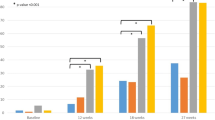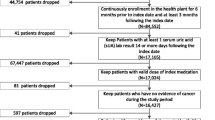Abstract
Introduction/objectives
Lifelong urate-lowering therapy (ULT) with xanthine oxidase inhibitors (XOIs), such as allopurinol and febuxostat, is the cornerstone of gout treatment. This study aimed to compare drug persistence between allopurinol and febuxostat as first-line ULT in patients with gout in real practice.
Method
In this retrospective cohort study, we evaluated 602 patients with gout in whom allopurinol or febuxostat was newly initiated from December 2011 to November 2018 at a tertiary rheumatology centre. Persistence was defined as the duration from the first description date to the end of treatment with XOIs or the end of the study period (November 2019).
Results
Among the 602 gout patients, the mean age was 60.2 years and 234 (38.9%) patients had tophi. Allopurinol and febuxostat were started in 237 (39.3%) and 365 (60.6%) patients, respectively. During the study period, 282 (46.8%) patients stopped taking XOIs, and the most common reason for XOI withdrawal was poor health literacy (61.3%). The 1- and 5-year persistence rates of XOIs were 67.2% and 40.9%, respectively. In the Kaplan–Meier analysis, persistence rates of allopurinol were significantly lower than those of febuxostat (p < 0.001). In the multivariable Cox regression model, allopurinol use was a significant risk factor for discontinuation of XOIs (HR = 2.01, p < 0.001). In addition, the presence of tophi and symptom duration < 24 months was independently associated with a higher risk of XOI withdrawal.
Conclusions
Long-term persistence of XOIs was suboptimal, and allopurinol had worse persistence rates than febuxostat among patients with gout.
Key Points • Long-term persistence of xanthine oxidase inhibitors (XOIs) as first-line urate-lowering therapy (ULT) among patients with gout was suboptimal, and the major reason for XOI discontinuation was poor health literacy in our study. • We demonstrated that allopurinol had worse persistence rates than febuxostat among patients with gout, suggesting that febuxostat is a better option for long-term ULT in light of medication adherence in a real-world setting. • Patients with gout with tophi and shorter symptom duration were found to be at high risk for poor persistence of XOIs. |


Similar content being viewed by others
Data Availability
The datasets used and/or analysed in the present study are available from the corresponding author on reasonable request.
References
Khanna D, Fitzgerald JD, Khanna PP, Bae S, Singh MK, Neogi T, Pillinger MH, Merill J, Lee S, Prakash S, Kaldas M, Gogia M, Perez-Ruiz F, Taylor W, Liote F, Choi H, Singh JA, Dalbeth N, Kaplan S, Niyyar V, Jones D, Yarows SA, Roessler B, Kerr G, King C, Levy G, Furst DE, Edwards NL, Mandell B, Schumacher HR, Robbins M, Wenger N, Terkeltaub R (2012) 2012 American College of Rheumatology guidelines for management of gout. Part 1: systematic nonpharmacologic and pharmacologic therapeutic approaches to hyperuricemia. Arthritis Care Res 64(10):1431–1446. https://doi.org/10.1002/acr.21772
Richette P, Doherty M, Pascual E, Barskova V, Becce F, Castaneda-Sanabria J, Coyfish M, Guillo S, Jansen TL, Janssens H, Liote F, Mallen C, Nuki G, Perez-Ruiz F, Pimentao J, Punzi L, Pywell T, So A, Tausche AK, Uhlig T, Zavada J, Zhang W, Tubach F, Bardin T (2017) 2016 updated EULAR evidence-based recommendations for the management of gout. Ann Rheum Dis 76(1):29–42. https://doi.org/10.1136/annrheumdis-2016-209707
Scheepers L, van Onna M, Stehouwer CDA, Singh JA, Arts ICW, Boonen A (2018) Medication adherence among patients with gout: a systematic review and meta-analysis. Semin Arthritis Rheum 47(5):689–702. https://doi.org/10.1016/j.semarthrit.2017.09.007
De Vera MA, Marcotte G, Rai S, Galo JS, Bhole V (2014) Medication adherence in gout: a systematic review. Arthritis Care Res 66(10):1551–1559. https://doi.org/10.1002/acr.22336
Yin R, Li L, Zhang G, Cui Y, Zhang L, Zhang Q, Fu T, Cao H, Gu Z (2018) Rate of adherence to urate-lowering therapy among patients with gout: a systematic review and meta-analysis. BMJ Open 8(4):e017542. https://doi.org/10.1136/bmjopen-2017-017542
Lee S, So MW (2016) Adherence with urate-lowering therapies among male patients with gout in a routine clinical setting. Mod Rheumatol 26(6):950–955. https://doi.org/10.3109/14397595.2016.1170914
Perez-Ruiz F, Desideri G (2018) Improving adherence to gout therapy: an expert review. Ther Clin Risk Manag 14:793–802. https://doi.org/10.2147/TCRM.S162956
Nasser-Ghodsi N, Harrold LR (2015) Overcoming adherence issues and other barriers to optimal care in gout. Curr Opin Rheumatol 27(2):134–138. https://doi.org/10.1097/BOR.0000000000000141
Bardin T, Richette P (2019) The role of febuxostat in gout. Curr Opin Rheumatol 31(2):152–158. https://doi.org/10.1097/BOR.0000000000000573
White WB, Saag KG, Becker MA, Borer JS, Gorelick PB, Whelton A, Hunt B, Castillo M, Gunawardhana L, Investigators C (2018) Cardiovascular safety of febuxostat or allopurinol in patients with gout. N Engl J Med 378(13):1200–1210. https://doi.org/10.1056/NEJMoa1710895
Wallace SL, Robinson H, Masi AT, Decker JL, McCarty DJ, Yu TF (1977) Preliminary criteria for the classification of the acute arthritis of primary gout. Arthritis Rheum 20(3):895–900. https://doi.org/10.1002/art.1780200320
Neogi T, Jansen TL, Dalbeth N, Fransen J, Schumacher HR, Berendsen D, Brown M, Choi H, Edwards NL, Janssens HJ, Liote F, Naden RP, Nuki G, Ogdie A, Perez-Ruiz F, Saag K, Singh JA, Sundy JS, Tausche AK, Vazquez-Mellado J, Yarows SA, Taylor WJ (2015) 2015 gout classification criteria: an American College of Rheumatology/European league against rheumatism collaborative initiative. Arthritis Rheumatol 67(10):2557–2568. https://doi.org/10.1002/art.39254
Neogi T, Jansen TL, Dalbeth N, Fransen J, Schumacher HR, Berendsen D, Brown M, Choi H, Edwards NL, Janssens HJ, Liote F, Naden RP, Nuki G, Ogdie A, Perez-Ruiz F, Saag K, Singh JA, Sundy JS, Tausche AK, Vaquez-Mellado J, Yarows SA, Taylor WJ (2015) 2015 gout classification criteria: an American College of Rheumatology/European league against rheumatism collaborative initiative. Ann Rheum Dis 74(10):1789–1798. https://doi.org/10.1136/annrheumdis-2015-208237
Harrold LR, Andrade SE, Briesacher B, Raebel MA, Fouayzi H, Yood RA, Ockene IS (2010) The dynamics of chronic gout treatment: medication gaps and return to therapy. Am J Med 123(1):54–59. https://doi.org/10.1016/j.amjmed.2009.05.026
Janssen CA, Oude Voshaar MAH, Vonkeman HE, Krol M, van de Laar M (2018) A retrospective analysis of medication prescription records for determining the levels of compliance and persistence to urate-lowering therapy for the treatment of gout and hyperuricemia in the Netherlands. Clin Rheumatol 37(8):2291–2296. https://doi.org/10.1007/s10067-018-4127-x
Khanna D, Khanna PP, Fitzgerald JD, Singh MK, Bae S, Neogi T, Pillinger MH, Merill J, Lee S, Prakash S, Kaldas M, Gogia M, Perez-Ruiz F, Taylor W, Liote F, Choi H, Singh JA, Dalbeth N, Kaplan S, Niyyar V, Jones D, Yarows SA, Roessler B, Kerr G, King C, Levy G, Furst DE, Edwards NL, Mandell B, Schumacher HR, Robbins M, Wenger N, Terkeltaub R (2012) 2012 American College of Rheumatology guidelines for management of gout. Part 2: therapy and antiinflammatory prophylaxis of acute gouty arthritis. Arthritis Care Res 64(10):1447–1461. https://doi.org/10.1002/acr.21773
Zandman-Goddard G, Amital H, Shamrayevsky N, Raz R, Shalev V, Chodick G (2013) Rates of adherence and persistence with allopurinol therapy among gout patients in Israel. Rheumatology (Oxford) 52(6):1126–1131. https://doi.org/10.1093/rheumatology/kes431
Singh JA, Hodges JS, Asch SM (2009) Opportunities for improving medication use and monitoring in gout. Ann Rheum Dis 68(8):1265–1270. https://doi.org/10.1136/ard.2008.092619
Briesacher BA, Andrade SE, Fouayzi H, Chan KA (2008) Comparison of drug adherence rates among patients with seven different medical conditions. Pharmacotherapy 28(4):437–443. https://doi.org/10.1592/phco.28.4.437
Park H, Rascati KL, Prasla K, McBayne T (2012) Evaluation of health care costs and utilization patterns for patients with gout. Clin Ther 34(3):640–652. https://doi.org/10.1016/j.clinthera.2012.01.020
McGowan B, Bennett K, Silke C, Whelan B (2016) Adherence and persistence to urate-lowering therapies in the Irish setting. Clin Rheumatol 35(3):715–721. https://doi.org/10.1007/s10067-014-2823-8
Lee S, So MW, Ahn E (2019) Long-term adherence and persistence with febuxostat among male patients with gout in a routine clinical setting. Mod Rheumatol 29(4):662–668. https://doi.org/10.1080/14397595.2018.1483293
Park JH, Park EK, Koo DW, Lee S, Lee SH, Kim GT, Lee SG (2017) Compliance and persistence with oral bisphosphonates for the treatment of osteoporosis in female patients with rheumatoid arthritis. BMC Musculoskelet Disord 18(1):152. https://doi.org/10.1186/s12891-017-1514-4
Stewart S, Dalbeth N, Otter S, Gow P, Kumar S, Rome K (2017) Clinically-evident tophi are associated with reduced muscle force in the foot and ankle in people with gout: a cross-sectional study. J Foot Ankle Res 10:25. https://doi.org/10.1186/s13047-017-0207-4
Disveld IJM, Zoakman S, Jansen T, Rongen GA, Kienhorst LBE, Janssens H, Fransen J, Janssen M (2019) Crystal-proven gout patients have an increased mortality due to cardiovascular diseases, cancer, and infectious diseases especially when having tophi and/or high serum uric acid levels: a prospective cohort study. Clin Rheumatol 38(5):1385–1391. https://doi.org/10.1007/s10067-019-04520-6
Levey AS, Stevens LA, Schmid CH, Zhang YL, Castro AF 3rd, Feldman HI, Kusek JW, Eggers P, Van Lente F, Greene T, Coresh J (2009) A new equation to estimate glomerular filtration rate. Ann Intern Med 150(9):604–612. https://doi.org/10.7326/0003-4819-150-9-200905050-00006
Cramer JA, Roy A, Burrell A, Fairchild CJ, Fuldeore MJ, Ollendorf DA, Wong PK (2008) Medication compliance and persistence: terminology and definitions. Value Health 11(1):44–47. https://doi.org/10.1111/j.1524-4733.2007.00213.x
Halpern R, Mody RR, Fuldeore MJ, Patel PA, Mikuls TR (2009) Impact of noncompliance with urate-lowering drug on serum urate and gout-related healthcare costs: administrative claims analysis. Curr Med Res Opin 25(7):1711–1719. https://doi.org/10.1185/03007990903017966
Park JA, Lee MY, Nam JH, Shin JY, Wood R, Holbrook T, Kwon SH (2020) Real-world treatment persistence of non-tumor necrosis factor inhibitors versus tumor necrosis factor inhibitors among patients with rheumatoid arthritis in South Korea. Curr Med Res Opin 36(2):343–351. https://doi.org/10.1080/03007995.2019.1688271
Love BL, Barrons R, Veverka A, Snider KM (2010) Urate-lowering therapy for gout: focus on febuxostat. Pharmacotherapy 30(6):594–608. https://doi.org/10.1592/phco.30.6.594
Stamp LK, Day RO, Yun J (2016) Allopurinol hypersensitivity: investigating the cause and minimizing the risk. Nat Rev Rheumatol 12(4):235–242. https://doi.org/10.1038/nrrheum.2015.132
Demian MN, Shapiro RJ, Thornton WL (2016) An observational study of health literacy and medication adherence in adult kidney transplant recipients. Clin Kidney J 9(6):858–865. https://doi.org/10.1093/ckj/sfw076
Lee YM, Yu HY, You MA, Son YJ (2017) Impact of health literacy on medication adherence in older people with chronic diseases. Collegian 24(1):11–18. https://doi.org/10.1016/j.colegn.2015.08.003
Lindquist LA, Go L, Fleisher J, Jain N, Friesema E, Baker DW (2012) Relationship of health literacy to intentional and unintentional non-adherence of hospital discharge medications. J Gen Intern Med 27(2):173–178. https://doi.org/10.1007/s11606-011-1886-3
van Onna M, Hinsenveld E, de Vries H, Boonen A (2015) Health literacy in patients dealing with gout: a qualitative study. Clin Rheuamtol 34(9):1599–1603. https://doi.org/10.1007/s10067-014-2838-1
Goldfien RD, Ng MS, Yip G, Hwe A, Jacobson A, Pressman A, Avins AL (2014) Effectiveness of a pharmacist-based gout care management programme in a large integrated health plan: results from a pilot study. BMJ Open 4(1):e003627. https://doi.org/10.1136/bmjopen-2013-003627
Rees F, Jenkins W, Doherty M (2013) Patients with gout adhere to curative treatment if informed appropriately: proof-of-concept observational study. Ann Rheum Dis 72(6):826–830. https://doi.org/10.1136/annrheumdis-2012-201676
Solomon DH, Avorn J, Levin R, Brookhart MA (2008) Uric acid lowering therapy: prescribing patterns in a large cohort of older adults. Ann Rheum Dis 67(5):609–613. https://doi.org/10.1136/ard.2007.076182
Neame R, Hammond A (2005) Beliefs about medications: a questionnaire survey of people with rheumatoid arthritis. Rheumatology (Oxford) 44(6):762–767. https://doi.org/10.1093/rheumatology/keh587
Sarawate CA, Brewer KK, Yang W, Patel PA, Schumacher HR, Saag KG, Bakst AW (2006) Gout medication treatment patterns and adherence to standards of care from a managed care perspective. Mayo Clin Proc 81(7):925–934. https://doi.org/10.4065/81.7.925
Rashid N, Levy GD, Wu YL, Zheng C, Koblick R, Cheetham TC (2015) Patient and clinical characteristics associated with gout flares in an integrated healthcare system. Rheumatol Int 35(11):1799–1807. https://doi.org/10.1007/s00296-015-3284-3
Acknowledgments
We specially thank the late Professor Sung-Il Kim who devoted himself to education, research, and patient care in Division of Rheumatology, Department of Internal Medicine, Pusan National University School of Medicine (1963 to 2011).
Author information
Authors and Affiliations
Contributions
A Kim: study design, data collection and analysis and writing manuscript, YK Kim: data interpretation, GT Kim: data interpretation and revision of manuscript, MW So: data interpretation and revision of manuscript, E Ahn: data interpretation, SG Lee: study design, data analysis and interpretation, writing manuscript and coordination of entire study.
Corresponding author
Ethics declarations
Ethical approval
Ethical approval was obtained via the Research and Ethical Review Board of Pusan National University Hospital, which waived informed consent due to retrospective study design (IRB no. 1912–021-086).
Disclosures
None.
Additional information
Publisher’s note
Springer Nature remains neutral with regard to jurisdictional claims in published maps and institutional affiliations.
Rights and permissions
About this article
Cite this article
Kim, A., Kim, Y., Kim, GT. et al. Comparison of persistence rates between allopurinol and febuxostat as first-line urate-lowering therapy in patients with gout: an 8-year retrospective cohort study. Clin Rheumatol 39, 3769–3776 (2020). https://doi.org/10.1007/s10067-020-05161-w
Received:
Revised:
Accepted:
Published:
Issue Date:
DOI: https://doi.org/10.1007/s10067-020-05161-w




